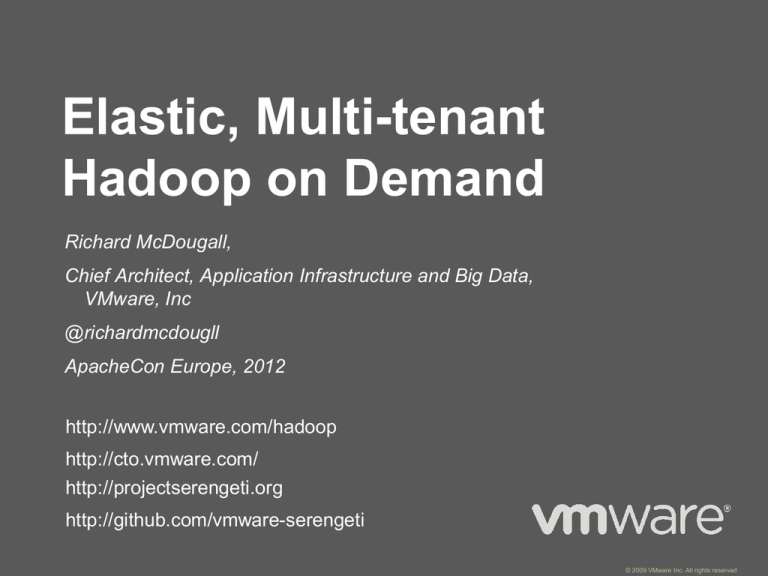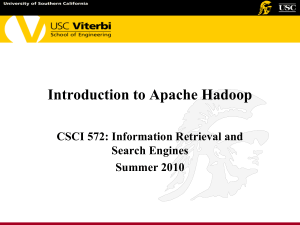
Elastic, Multi-tenant
Hadoop on Demand
Richard McDougall,
Chief Architect, Application Infrastructure and Big Data,
VMware, Inc
@richardmcdougll
ApacheCon Europe, 2012
http://www.vmware.com/hadoop
http://cto.vmware.com/
http://projectserengeti.org
http://github.com/vmware-serengeti
© 2009 VMware Inc. All rights reserved
Broad Application of Hadoop technology
Horizontal Use Cases
Vertical Use Cases
Log Processing / Click
Stream Analytics
Financial Services
Machine Learning /
sophisticated data mining
Internet Retailer
Web crawling / text
processing
Pharmaceutical / Drug
Discovery
Extract Transform Load
(ETL) replacement
Mobile / Telecom
Image / XML message
processing
Scientific Research
General archiving /
compliance
Social Media
Hadoop’s ability to handle large unstructured data affordably and efficiently makes
it a valuable tool kit for enterprises across a number of applications and fields.
How does Hadoop enable parallel processing?
A framework for distributed processing of large data sets across
clusters of computers using a simple programming model.
Source: http://architects.dzone.com/articles/how-hadoop-mapreduce-works
Hadoop System Architecture
MapReduce: Programming
framework for highly parallel data
processing
Hadoop Distributed File System
(HDFS): Distributed data storage
Job Tracker Schedules Tasks Where the Data Resides
Job
Tracker
Job
Input File
Split 1 – 64MB
Split 2 – 64MB
Split 3 – 64MB
Input File
Host 1
Task
Tracker
Host 2
Task
Tracker
Host 3
Task
Tracker
Task - 1
Task - 2
Task - 3
DataNode
DataNode
DataNode
Block 1 – 64MB
Block 2 – 64MB
Block 3 – 64MB
Hadoop Distributed File System
Hadoop Data Locality and Replication
The Right Big Data Tools for the Right Job…
Real
Time
Streams
Machine
Learning
(Mahout, etc…)
(Social,
sensors)
Real-Time
Processing
Data Visualization
(s4, storm,
spark)
ETL
(Excel, Tableau)
Real Time
Database
(Shark,
Gemfire, hBase,
Cassandra)
(Informatica,
Talend, Spring
Integration)
Interactive
Analytics
(Impala,
Greenplum,
AsterData,
Netezza…)
Structured and Unstructured Data
(HDFS, MAPR)
Cloud Infrastructure
Compute
Storag
e
Networking
HIVE
Batch
Processing
(Map-Reduce)
So yes, there’s a lot more than just MapReduce…
Hadoop
batch analysis
Compute
layer
HBase
real-time queries
Big SQL –
Impala
Other
NoSQL –
Cassandra,
Mongo, etc
Data
layer
HDFS
Spark,
Shark,
Solr,
Platfora,
Etc,…
Some sort of distributed, resource management OS + Filesystem
Host
Host
Host
Host
Host
Host
Host
Elasticity Enables Sharing of Resources
Containers with Isolation are a Tried and Tested
Approach
Reckless Workload 2
Hungry Workload 1
Sneaky
Workload 3
Some sort of distributed, resource management OS + Filesystem
Host
Host
Host
Host
Host
Host
Host
Mixing Workloads: Three big types of
Isolation are Required
Resource Isolation
• Control the greedy noisy neighbor
• Reserve resources to meet needs
Version Isolation
• Allow concurrent OS, App, Distro versions
Security Isolation
• Provide privacy between users/groups
• Runtime and data privacy required
Some sort of distributed, resource management OS + Filesystem
Host
Host
Host
Host
Host
Host
Host
Community activity in Isolation and Resource
Management
YARN
• Goal: Support workloads other than M-R on Hadoop
• Initial need is for MPI/M-R from Yahoo
• Not quite ready for prime-time yet?
• Non-posix File system self selects workload types
Mesos
• Distributed Resource Broker
• Mixed Workloads with some RM
• Active project, in use at Twitter
• Leverages OS Virtualization – e.g. cgroups
Virtualization
• Virtual machine as the primary isolation, resource management and
versioned deployment container
• Basis for Project Serengeti
Project Serengeti – Hadoop on Virtualization
Simple to Operate
Rapid deployment
Unified operations
across enterprise
Easy Clone of Cluster
Highly Available
Elastic Scaling
No more single point
of failure
Shrink and expand
cluster on demand
One click to setup
Resource Guarantee
High availability for
MR Jobs
Independent scaling
of Compute and data
Serengeti is an Open Source Project to automate deployment of
Hadoop on virtual platforms
http://projectserengeti.org
http://github.com/vmware-serengeti
Common Infrastructure for Big Data
MPP DB
HBase
Hadoop
Virtualization Platform
Virtualization Platform
Hadoop
HBase
Cluster Consolidation
MPP DB
Simplify
Cluster Sprawling
Single purpose clusters for various
business applications lead to cluster
sprawl.
• Single Hardware Infrastructure
• Unified operations
Optimize
• Shared Resources = higher utilization
• Elastic resources = faster on-demand access
Evolution of Hadoop on VMs
Slave Node
VM
VM
VM
Current
Hadoop:
Combined
Storage/
Compute
Compute
VM
VM
T1
T2
VM
Storage
Storage
Hadoop in VM
Separate Storage
Separate Compute Clusters
- VM lifecycle
determined
by Datanode
- Limited elasticity
- Limited to Hadoop
Multi-Tenancy
- Separate compute
from data
- Elastic compute
- Enable shared
workloads
- Raise utilization
- Separate virtual clusters
per tenant
- Stronger VM-grade security
and resource isolation
- Enable deployment of
multiple Hadoop runtime
versions
In-house Hadoop as a Service “Enterprise EMR” –
(Hadoop + Hadoop)
Production
ETL of log files
Ad hoc
data mining
Compute
layer
Production
recommendation engine
HDFS
HDFS
Data
layer
Virtualization platform
Host
Host
Host
Host
Host
Host
Integrated Hadoop and Webapps – (Hadoop +
Other Workloads)
Short-lived
Hadoop compute cluster
Compute
layer
Hadoop
compute cluster
Data
layer
Web servers
for ecommerce site
HDFS
Virtualization platform
Host
Host
Host
Host
Host
Host
Integrated Big Data Production – (Hadoop + other
big data)
Hadoop
batch analysis
Compute
layer
HBase
real-time queries
Big SQL –
Impala
Other
NoSQL –
Cassandra,
Mongo, etc
Data
layer
HDFS
Spark,
Shark,
Solr,
Platfora,
Etc,…
Virtualization
Host
Host
Host
Host
Host
Host
Host
Deploy a Hadoop Cluster in under 30 Minutes
Step 1: Deploy Serengeti virtual appliance on vSphere.
Deploy vHelperOVF to
vSphere
Step 2: A few simple commands to stand up Hadoop Cluster.
Select Compute, memory,
storage and network
Select configuration template
Automate deployment
Done
A Tour Through Serengeti
$ ssh serengeti@serengeti-vm
$ serengeti
serengeti>
A Tour Through Serengeti
serengeti> cluster create --name dcsep
serengeti> cluster list
name: dcsep, distro: apache, status: RUNNING
NAME
ROLES
INSTANCE CPU MEM(MB) TYPE
----------------------------------------------------------------------------master
[hadoop_namenode, hadoop_jobtracker] 1
6
2048
LOCAL
data
[hadoop_datanode]
1
2
1024
LOCAL
compute [hadoop_tasktracker]
8
2
1024
LOCAL
client
[hadoop_client, pig, hive]
1
1
3748
LOCAL
10
10
10
10
Serengeti Spec File
[
"distro":"apache",
Choice of Distro
{
"name": "master",
"roles": [
"hadoop_NameNode",
"hadoop_jobtracker"
],
"instanceNum": 1,
"instanceType": "MEDIUM",
“ha”:true,
HA Option
},
{
"name": "worker",
"roles": [
"hadoop_datanode", "hadoop_tasktracker"
],
"instanceNum": 5,
"instanceType": "SMALL",
"storage": {
Choice of Shared Storage or Local Disk
"type": "LOCAL",
"sizeGB": 10
}
},
]
Fully Customizable Configuration Profile
Tune Hadoop cluster config in Serengeti spec file
"configuration": {
"hadoop": {
"mapred-site.xml": {
"mapred.jobtracker.taskScheduler": "org.apache.hadoop.mapred.FairScheduler"
…
Control the placement of Hadoop nodes
"placementPolicies": {
"instancePerHost": 2,
"groupRacks": {
"type": "ROUNDROBIN",
"racks": ["rack1", "rack2", "rack3“]
…
Setup physical racks/hosts mapping topology
> topology upload --fileName <topology file name>
> topology list
Create Hadoop clusters using HVE topology
> cluster create --name XXX --topology HVE --distro <HVE-supported_distro>
Getting to Insights
Point compute only cluster to existing HDFS
… "externalHDFS": "hdfs://hostname-of-namenode:8020", …
Interact with HDFS from Serengeti CLI
> fs ls /tmp
> fs put --from /tmp/local.data --to /tmp/hdfs.data
Launch MapReduce/Pig/Hive jobs from Serengeti CLI
> cluster target --name myHadoop
> mr jar --jarfile /opt/serengeti/cli/lib/hadoop-examples-1.0.1.jar
--mainclass org.apache.hadoop.examples.PiEstimator --args "100 1000000000"
Deploy Hive Server for ODBC/JDBC services
"name": "client",
"roles": [
"hadoop_client",
"hive",
"hive_server",
"pig"
], …
Configuring Distro’s
{
"name" : "cdh",
"version" : "3u3",
"packages" : [
{
"roles" : ["hadoop_NameNode", "hadoop_jobtracker",
"hadoop_tasktracker", "hadoop_datanode",
"hadoop_client"],
"tarball" : "cdh/3u3/hadoop-0.20.2-cdh3u3.tar.gz"
},
{
"roles" : ["hive"],
"tarball" : "cdh/3u3/hive-0.7.1-cdh3u3.tar.gz"
},
{
"roles" : ["pig"],
"tarball" : "cdh/3u3/pig-0.8.1-cdh3u3.tar.gz"
}
]
},
Serengeti Demo
Deploy Serengeti vApp on vSphere
Deploy a Hadoop cluster in 10 Minutes
Run MapReduce
Serengeti
Demo
Scale out the Hadoop cluster
Create a Customized Hadoop cluster
Use Your Favorite Hadoop Distribution
Serengeti Architecture
Java
Serengeti CLI
(spring-shell)
http://github.com/vmware-serengeti
Ruby
Serengeti Server
Serengeti web service
Resource
Mgr
DB
Cluster
Mgr
Network
mgr
Distro
mgr
Shell command to trigger deployment
Deploy Engine Proxy
(bash script)
Report deployment
progress and summary
Task
mgr
Knife cluster cli
RabbitMQ
Chef Orchestration Layer
(Ironfan)
(share with chef server)
package
service provisioning inside vms
server
Cloud Manager
Cluster provision engine
(vm CRUD)
cookbooks/roles
data bags
Chef bootstrap nodes
Chef server
download packages
Fog
vSphere Cloud provider
resource services
download
cookbook/recipes
vCenter
Hadoop node
Chef-client
Hadoop node
Hadoop node
Chef-client
Chef-client
Hadoop node
Chef-client
Client VM
Chef-client
Use Local Disk where it’s Needed
SAN Storage
NAS Filers
Local Storage
$2 - $10/Gigabyte
$1 - $5/Gigabyte
$0.05/Gigabyte
$1M gets:
0.5Petabytes
200,000 IOPS
8Gbyte/sec
$1M gets:
1 Petabyte
200,000 IOPS
10Gbyte/sec
$1M gets:
10 Petabytes
400,000 IOPS
250 Gbytes/sec
Rules of Thumb: Sizing for Hadoop
Disk:
• Provide about 50Mbytes/sec of disk bandwidth per core
• If using SATA, that’s about one disk per core
Network
• Provide about 200mbits of aggregate network bandwidth per core
Memory
• Use a memory:core ratio of about 4Gbytes:core
Extend Virtual Storage Architecture to Include
Local Disk
Hybrid Storage
Shared Storage: SAN or NAS
• SAN for boot images, VMs, other
• Easy to provision
workloads
• Local disk for Hadoop & HDFS
• Automated cluster rebalancing
Host
Host
Host
Host
Host
Host
Other VM
Hadoop
Hadoop
Other VM
Hadoop
Hadoop
Other VM
Other VM
Hadoop
Other VM
Hadoop
Hadoop
Other VM
Hadoop
Hadoop
Other VM
Other VM
Hadoop
• Scalable Bandwidth, Lower Cost/GB
Hadoop Using Local Disks
Task Tracker
Other
Workload
Datanode
Hadoop
Virtual
Machine
Ext4
Virtualization Host
Shared
Storage
OS Image - VMDK
VMDK
Ext4
Ext4
VMDK
VMDK
Native versus Virtual Platforms, 24 hosts, 12
disks/host
450
Elapsed time, seconds (lower is better)
400
350
Native
1 VM
300
2 VMs
4 VMs
250
200
150
100
50
0
TeraGen
TeraSort
TeraValidate
Local vs Various SAN Storage Configurations
4.5
Elapsed time ratio to Local disks (lower is
better)
16 x HP DL380G7, EMC VNX 7500, 96 physical disks
4
Local disks
SAN JBOD
SAN RAID-0, 16 KB page size
SAN RAID-0
SAN RAID-5
3.5
3
2.5
2
1.5
1
0.5
0
TeraGen
TeraSort
TeraValidate
Hadoop Virtualization Extensions: Topology
Awareness
Virtual Topologies
Hadoop Topology Changes for Virtualization
Hadoop Virtualization Extensions for Topology
HVE
Task Scheduling Policy Extension
Balancer Policy Extension
Replica Choosing Policy Extension
Replica Placement Policy Extension
Replica Removal Policy Extension
Network Topology Extension
Hadoop
HDFS
MapReduce
Hadoop Common
HADOOP-8468 (Umbrella JIRA)
HADOOP-8469
Terasort locality
HDFS-3495
MAPREDUCE-4310
Normal
HDFS-3498
Normal with HVE
MAPREDUCE-4309
HADOOP-8470
D/C separation
HADOOP-8472
D/C separation with HVE
Data
Local
Nodegroup
Local
Rack
Local
392
-
8
397
2
1
0
-
400
0
400
0
Why Virtualize Hadoop?
Simple to Operate
Rapid deployment
Unified operations
across enterprise
Easy Clone of Cluster
Highly Available
Elastic Scaling
No more single point
of failure
Shrink and expand
cluster on demand
One click to setup
Resource Guarantee
High availability for
MR Jobs
Independent scaling
of Compute and data
Live Machine Migration Reduces Planned
Downtime
Description:
Enables the live migration of virtual
machines from one host to another
with continuous service availability.
Benefits:
•
Revolutionary technology that is the
basis for automated virtual machine
movement
•
Meets service level and performance
goals
vSphere High Availability (HA) - protection
against unplanned downtime
Overview
• Protection against host and VM failures
• Automatic failure detection (host, guest OS)
• Automatic virtual machine restart in minutes, on any available host in cluster
• OS and application-independent, does not require complex configuration
changes
Example HA Failover for Hadoop
Serengeti
Server
Namenode
vSphere HA
Namenode
TaskTracker
TaskTracker
TaskTracker
TaskTracker
HDFS Datanode
HDFS Datanode
HDFS Datanode
HDFS Datanode
Hive
Hive
Hive
Hive
hBase
hBase
hBase
hBase
vSphere Fault Tolerance provides continuous
protection
Overview
• Single identical VMs running in
lockstep on separate hosts
XX
App
App
HA
HA
OS
OS
• Zero downtime, zero data loss
App
OS
VMware ESX
FT
App
App
App
App
OS
OS
OS
OS
VMware ESX
failover for all virtual machines in
case of hardware failures
• Integrated with VMware HA/DRS
• No complex clustering or
specialized hardware required
X
• Single common mechanism for all
applications and operating
systems
Zero downtime for Name Node, Job Tracker and other components in Hadoop clusters
High Availability for the Hadoop Stack
Pig (Data
Flow)
BI Reporting
RDBMS
Hive (SQL)
HCatalog
Hive
MetaDB
Hcatalog MDB
MapReduce (Job Scheduling/Execution System)
HBase (Key-Value store)
HDFS
Jobtracker
Namenode
(Hadoop Distributed File System)
Management Server
Zookeepr (Coordination)
ETL Tools
Server
Performance Effect of FT for Master Daemons
NameNode and JobTracker placed in separate UP VMs
Small overhead: Enabling FT causes 2-4% slowdown for TeraSort
Elapsed time ratio to FT off
8 MB case places similar load on NN &JT as >200 hosts with 256 MB
1.04
TeraSort
1.03
1.02
1.01
1
256
64
16
HDFS block size, MB
8
Why Virtualize Hadoop?
Simple to Operate
Rapid deployment
Unified operations
across enterprise
Easy Clone of Cluster
Highly Available
Elastic Scaling
No more single point
of failure
Shrink and expand
cluster on demand
One click to setup
Resource Guarantee
High availability for
MR Jobs
Independent scaling
of Compute and data
Other VM
Other VM
Other VM
VM
Other
Hadoop
Hadoop
VM
Other
Other VM
Other VM
Other VM
Hadoop
VM
Other
Hadoop
VM
Other
Other VM
Other VM
Other VM
VM
Other
Hadoop
Hadoop
VM
Other
“Time Share”
Serengeti
VMware vSphere
Host
Host
Host
HDFS
HDFS
HDFS
While existing apps run during the day to support business
operations, Hadoop batch jobs kicks off at night to conduct
deep analysis of data.
Hadoop Task Tracker and Data Node in a VM
Slot
Add/Remove
Slots?
Slot
Other
Workload
Virtual
Hadoop
Node
Task Tracker
Datanode
Grow/Shrink
by tens of GB?
Virtualization Host
Grow/Shrink of a VM is one
approach
VMDK
Add/remove Virtual Nodes
Other
Workload
Virtual
Hadoop
Node
Virtualization Host
Just add/remove more
virtual nodes?
Slot
Slot
Slot
Slot
Task Tracker
Virtual
Hadoop
Node
Task Tracker
Datanode
Datanode
VMDK
VMDK
But State makes it hard to power-off a node
Slot
Slot
Other
Workload
Virtual
Hadoop
Node
Task Tracker
Datanode
Virtualization Host
Powering off the Hadoop VM
would in effect fail the datanode
VMDK
Adding a node needs data…
Other
Workload
Virtualization Host
Virtual
Hadoop
Node
Slot
Slot
Slot
Slot
Task Tracker
Virtual
Hadoop
Node
Task Tracker
Datanode
Datanode
VMDK
VMDK
Adding a node would require TBs of
data replication
Separated Compute and Data
Slot
Virtual
Hadoop
Node
Other
Workload
Slot
Task Tracker
Virtual
Hadoop
Node
Virtualization Host
Truly Elastic Hadoop:
Scalable through virtual
nodes
Slot
Slot
Virtual
Slot
Virtual
Hadoop
Virtual
Slot
Hadoop
Node
Hadoop
Node
Node
Task Tracker
Task Tracker
Datanode
VMDK
VMDK
Dataflow with separated Compute/Data
Slot
Virtual
Hadoop
Node
Slot
NodeManager
Virtual NIC
Virtualization Host
Virtual
Hadoop
Node
Datanode
Virtual NIC
Virtual Switch
NIC Drivers
VMDK
Elastic Compute
Set number of active TaskTracker nodes
> cluster limit --name myHadoop --nodeGroup worker --activeComputeNodeNum 8
Enable all the TaskTrackers in the cluster
> cluster unlimit --name myHadoop
Performance Analysis of Separation
Combined mode
Split Mode
1 Combined Compute/Datanode VM per Host
1 Datanode VM, 1 Compute node VM per Host
Task Tracker
Datanode
Task Tracker
Task Tracker
Task Tracker
Datanode
Datanode
Datanode
Workload: Teragen, Terasort, Teravalidate
HW Configuration: 8 cores, 96GB RAM, 16 disks per host x 2 nodes
Performance Analysis of Separation
Minimum performance impact with separation of compute and data
Elapsed time: ratio to combined
1.2
1
0.8
Combined
Split
0.6
0.4
0.2
0
Teragen
Terasort
Teravalidate
Freedom of Choice and Open Source
Distributions
Community Projects
• Flexibility to choose from major distributions
cluster create --name myHadoop --distro apache
• Support for multiple projects
• Open architecture to welcome industry participation
• Contributing Hadoop Virtualization Extensions (HVE) to open
source community
Elastic, Multi-tenant
Hadoop on Demand
Richard McDougall,
Chief Architect, Application Infrastructure and Big Data,
VMware, Inc
@richardmcdougll
ApacheCon Europe, 2012
http://www.vmware.com/hadoop
http://cto.vmware.com/
http://projectserengeti.org
http://github.com/vmware-serengeti
© 2009 VMware Inc. All rights reserved








